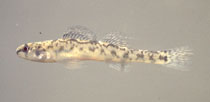Fish Iowa - Fish Species - Bluntnose Darter

Characteristics
A slender, straw-colored darter with about six dark cross-bars on the back and small W and X-shaped markings scattered over the back and sides. Upper lip and snout are separated by a continuous groove, not connected at midline by a bridge of skin as in many darters. Midline of belly is without enlarged and modified scales. Gill covers are not broadly connected by membrane across the throat; distance from membrane notch to front of lower lip is equal to or less than the distance from the notch to the front of the pelvic fin base. Anal fin with one thin, flexible spine and 7 to 9 rays. Spinous dorsal with 9 or 10 spines. Similar to Johnny Darter, but with the following differences: snout more bluntly rounded; dark streak extending forward onto snout from eye meeting its opposite on tip of snout; cheek fully scaled; soft dorsal with 10 or 11 rays; lateral line incomplete, usually ending beneath soft dorsal; dorsal fins more widely separated. Similar in color to the Johnny Darter, but smaller, not over 2 inches long.
Foods
Unknown, likely immature stages of aquatic insects
Expert Tip
- No results found
Details
The Bluntnose Darter is an endangered species in Iowa (571 IAC 77.2(1) (2015)). This species was so rare that Iowa Fish and Fishing suggested that it may be extirpated from the state with the exception of a possible remnant population in the Mississippi River. In recent years, Bluntnose Darters have been documented in the Mississippi River as well as in the Little Maquoketa River watershed. Iowa is the northern limit of this species’ original range.
The habitat of the Bluntnose Darter has quiet water of low-gradient, with little or no current, reasonably firm substrates of sand, clay, mud or silt, and organic debris. It can be found in swamps, sloughs, bayous, ditches, intermittent and permanent streams, oxbows and backwaters. Researchers found that the Bluntnose Darter avoided clear ditches with dense growths of aquatic vegetation, while other studies note that oxbows and overflow pools of clear water and vegetation are desirable. The Bluntnose Darter can tolerate high turbidity, but its decline from Plains streams might be due to high siltation from row-crop production and overgrazing in the region.
The Bluntnose Darter is viewed as endangered according to the Iowa Wildlife Action Plan, and is on the endangered species list.
Recent stream sampling information is available from Iowa DNR's biological monitoring and assessment program.
Sources:
Harlan, J.R., E.B. Speaker, and J. Mayhew. 1987. Iowa fish and fishing. Iowa Conservation Commission, Des Moines, Iowa. 323pp.
Iowa Department of Natural Resources, Iowa Wildlife Action Plan
Loan-Wilsey, A. K., C. L. Pierce, K. L. Kane, P. D. Brown and R. L. McNeely. 2005. The Iowa Aquatic Gap Analysis Project Final Report. Iowa Cooperative Fish and Wildlife Research Unit, Iowa State University, Ames
Pflieger, W.L. 1997. The fishes of Missouri. Missouri Department of Conservation, Jefferson City, Missouri. 372 pp.
Photo credit: photo courtesy of Konrad P. Schmidt, copyright Konrad P. Schmidt
Distribution Map

The Bluntnose Darter typically lives in sluggish streams with low gradient and mud substrate, its abundance is mostly threatened by man's activities. They are extremely rare, a remnant population exists in the Mississippi River and the lower ends of its tributaries. The geographical location of Iowa is the northern limit of the original range of the Bluntnose Darter, which extended from extreme southern Minnesota to the Gulf Coast.
See our most recent distribution data for this species on the Iowa DNR's Bionet application.
Fishing is not allowed for this species.
If you catch this species, immediately return it to the water with as little injury as possible.